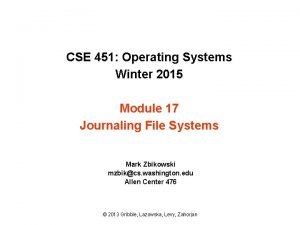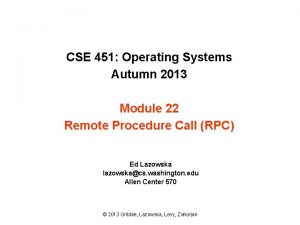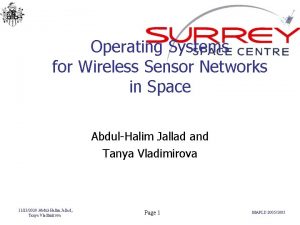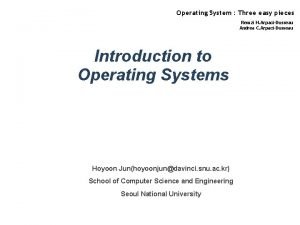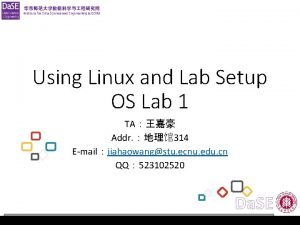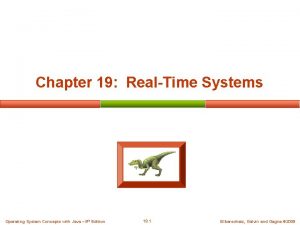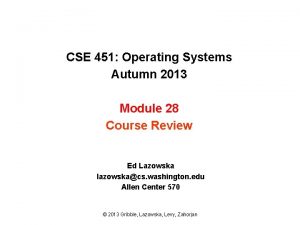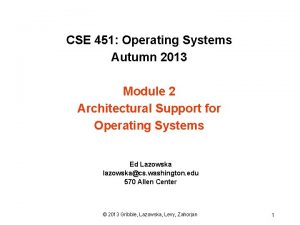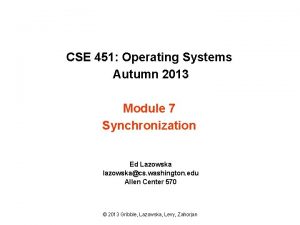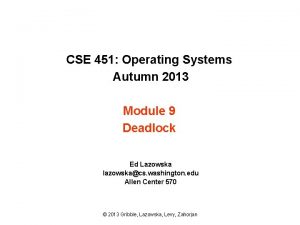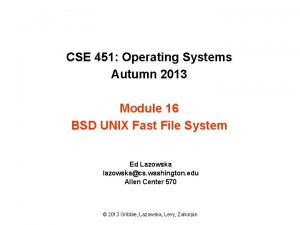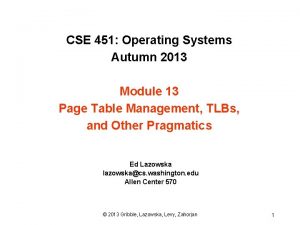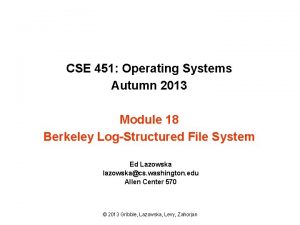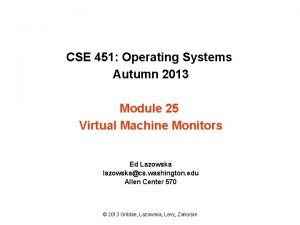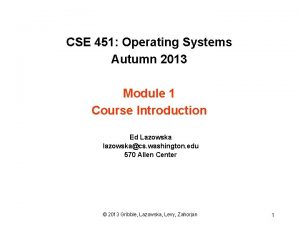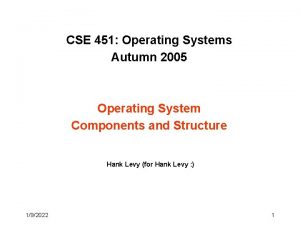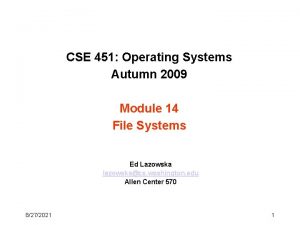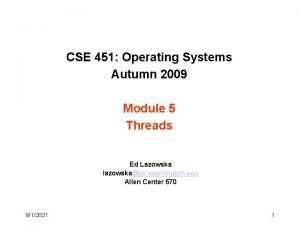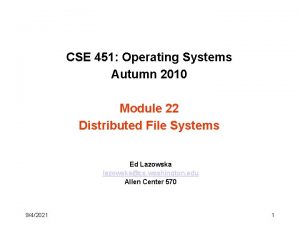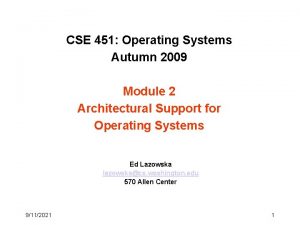CSE 451 Operating Systems Autumn 2013 Module 22

















- Slides: 17

CSE 451: Operating Systems Autumn 2013 Module 22 Remote Procedure Call (RPC) Ed Lazowska lazowska@cs. washington. edu Allen Center 570 © 2013 Gribble, Lazowska, Levy, Zahorjan

What’s Interesting about RPC? • RPC = Remote Procedure Call – the most common means for remote communication – used both by operating systems and applications • NFS is implemented as a set of RPCs • HTTP is essentially RPC • DCOM, CORBA, Java RMI, etc. , are just RPC systems • Allows you to communicate over a network with syntax and semantics very similar to local procedure call © 2013 Gribble, Lazowska, Levy, Zahorjan 2

Client/Server communication • The prevalent model for structuring distributed computation is the client/server paradigm – a server is a program (or collection of programs) that provides a service to other programs • e. g. , file server, name server, web server, mail server … • server/service may span multiple nodes (clusters) – often, nodes are called servers too – e, g. , the web server runs on a Dell server computer – a client is a program that uses the service • the client first binds to the server – locates it, establishes a network connection to it • the client then sends requests (with data) to perform actions, and the server sends responses (with data) – e. g. , web browser sends a “GET” request, server responds with a web page • TCP/IP is the transport, but what is the higher-level programming model? © 2013 Gribble, Lazowska, Levy, Zahorjan 3

Messages • Initially, people “hand-coded” messages to send requests and responses – message is a stream of bytes – “op codes” and operands • Lots of drawbacks – – need to worry about message format have to pack and unpack data from messages servers have to decode messages and dispatch to handlers messages are often asynchronous • after sending one, what do you do until response comes back? – messages aren’t a natural programming model © 2013 Gribble, Lazowska, Levy, Zahorjan 4

Procedure calls • Procedure calls are a natural way to structure multiple modules inside a single program – every language supports procedure calls – semantics are well-defined and well-understood – programmers are used to them • “Server” (called procedure) exports an API – think about a file system / file server API: open, close, read, write, sync, etc. • “Client” (calling procedure) calls the server procedure’s API • Linker binds the two together © 2013 Gribble, Lazowska, Levy, Zahorjan 5

Procedure call example Server API: int Add(int x, int y; Client Program: … sum = server->Add(3, 4); … Server Program: int Add(int x, int y) { return x + y; } • If the server were just a library, then “Add” would just be a local procedure call © 2013 Gribble, Lazowska, Levy, Zahorjan 6

Remote Procedure Call • Use procedure calls as the model for distributed (remote) communication – traditional procedure call syntax and semantics – have servers export a set of procedures that can be called by client programs • similar to library API, class definitions, etc. – clients do a local procedure call, as though they were directly linked with the server • under the covers, the procedure call is converted into a message exchange with the server • largely invisible to the programmer! © 2013 Gribble, Lazowska, Levy, Zahorjan 7

RPC issues • There a bunch of hard issues: – how do we make the “remote” part of RPC invisible to the programmer? • and is that a good idea? – what are the semantics of parameter passing? • what if we try to pass by reference? – how do we bind (locate/connect-to) servers? – how do we handle heterogeneity? • OS, language, architecture, … – how do we make it go fast? © 2013 Gribble, Lazowska, Levy, Zahorjan 8

RPC model • A server defines the service interface using an interface definition language (IDL) – the IDL specifies the names, parameters, and types for all client-callable server procedures • example: ASN. 1 in the OSI reference model • example: Sun’s XDR (external data representation) • A “stub compiler” reads the IDL declarations and produces two stub procedures for each server procedure – the server programmer implements the service’s procedures and links them with the server-side stubs – the client programmer implements the client program and links it with the client-side stubs – the stubs manage all of the details of remote communication between client and server using the RPC runtime system © 2013 Gribble, Lazowska, Levy, Zahorjan 9

RPC stubs • A client-side stub is a procedure that looks to the client as if it were a callable server procedure – it has the same API as the server’s implementation of the procedure – a client-side stub is just called a “stub” in Java RMI • A server-side stub looks like a caller to the server – it looks like a hunk of code that invokes the server procedure – a server-side stub is called a “skeleton” or “skel” in Java RMI • The client program thinks it’s invoking the server – but it’s calling into the client-side stub • The server program thinks it’s called by the client – but it’s really called by the server-side stub • The stubs send messages to each other, via the runtime, to make the RPC happen transparently © 2013 Gribble, Lazowska, Levy, Zahorjan 10

Procedure Call Server API: int Add(int x, int y; Client Program: … sum = server->Add(3, 4); … Server Program: int Add(int x, int y) { return x + y; } © 2013 Gribble, Lazowska, Levy, Zahorjan 11

Remote Procedure Call proc. call Client Program: Server Program: … sum = server->Add(3, 4); … int Add(int x, int y) { return x + y; } proc. call client-side stub: server-side stub: int Add(int x, int y) { alloc message buffer; mark as “add” call; store x, y in buffer; send message; receive response; unpack response; return response; } syscall/return RPC runtime system: send message to server; receive response; Message Add_Stub(Message m) { remove x, y from m; r = Add(x, y); allocate response buffer; store r in response; return response; } network comm. syscall/return RPC runtime system: receive message m; response = Add_Stub(m); send response to client; © 2013 Gribble, Lazowska, Levy, Zahorjan 12

Remote Procedure Call Client Program: Server Program: … sum = server->Add(3, 4); … int Add(int x, int y) { return x + y; } client-side stub: int Add(int x, int y) { alloc message buffer; mark as “add” call; store x, y in buffer; send message; receive response; unpack response; return response; } RPC runtime system: send message to server; receive response; server-side stub: Message Add_Stub(Message m) { remove x, y from m; r = Add(x, y); allocate response buffer; store r in response; return response; } RPC runtime system: Topics: • interface description • stubs • stub generation • parameter marshalling • binding • runtime system • error handling • performance • thread pools receive message m; response = Add_Stub(m); send response to client; © 2013 Gribble, Lazowska, Levy, Zahorjan 13

RPC marshalling • Marshalling is the packing of procedure parameters into a message packet – the RPC stubs call type-specific procedures to marshal or unmarshal the parameters of an RPC • the client stub marshals the parameters into a message • the server stub unmarshals the parameters and uses them to invoke the service’s procedure – on return: • the server stub marshals the return value • the client stub unmarshals the return value, and returns them to the client program © 2013 Gribble, Lazowska, Levy, Zahorjan 14

RPC binding • Binding is the process of connecting the client to the server – the server, when it starts up, exports interface • identifies itself to a network name server • tells RPC runtime that it is alive and ready to accept calls – the client, before issuing any calls, imports (binds to) the server • RPC runtime uses the name server to find the location of the server and establish a connection • The import and export operations are explicit in the server and client programs – a slight breakdown in transparency • more to come… © 2013 Gribble, Lazowska, Levy, Zahorjan 15

RPC transparency • One goal of RPC is to be as transparent as possible – make remote procedure calls look like local procedure calls – we’ve seen that binding breaks this transparency • What else breaks transparency? – failures: remote nodes/networks can fail in more ways than with local procedure calls • network partition, server crash • need extra support to handle failures • server can fail independently from client – “partial failure”: a big issue in distributed systems – if an RPC fails, was it invoked on the server? – performance: remote communication is inherently slower than local communication © 2013 Gribble, Lazowska, Levy, Zahorjan 16

RPC and thread pools • What happens if two client threads (or client programs) simultaneously invoke the same server using RPC? – ideally, two separate threads will run on the server – so, the RPC runtime system on the server needs to spawn or dispatch threads into server-side stubs when messages arrive • is there a limit on the number of threads? • if so, does this change semantics? • if not, what if 1, 000 clients simultaneously RPC into the same server? © 2013 Gribble, Lazowska, Levy, Zahorjan 17
 Module 4 operating systems and file management
Module 4 operating systems and file management Cse 451
Cse 451 Cse 451
Cse 451 C device module module 1
C device module module 1 2 example of operating system
2 example of operating system Evolution of operating systems
Evolution of operating systems Components of an operating system
Components of an operating system Operating system components
Operating system components Wsn operating systems
Wsn operating systems Three easy pieces
Three easy pieces Operating systems lab
Operating systems lab Introduction to operating systems
Introduction to operating systems Tanenbaum os
Tanenbaum os Components of operating system
Components of operating system What are the design issues of distributed operating system
What are the design issues of distributed operating system Early operating systems
Early operating systems Real-time operating systems
Real-time operating systems Can we make operating systems reliable and secure
Can we make operating systems reliable and secure

